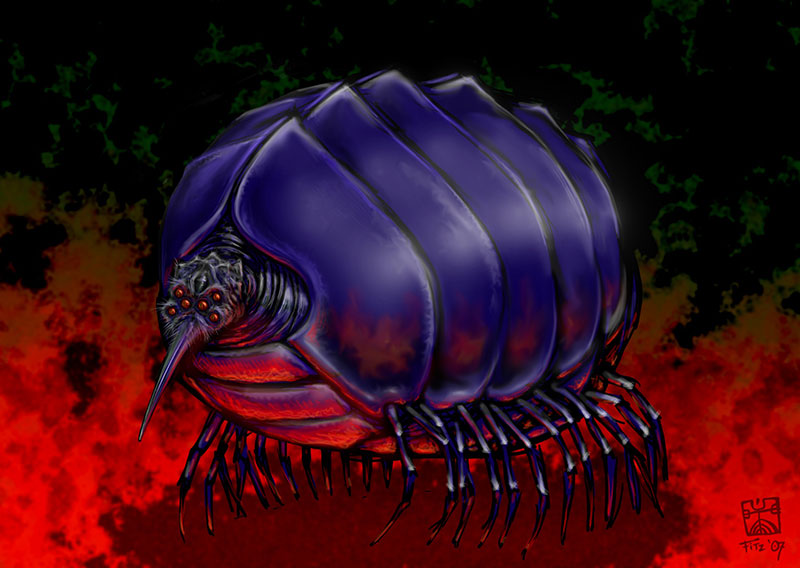

| Frequency: | Very Rare (common in parts of the Abyss) |
| No. Encountered: | 1-6 (40-400) |
| Size: | Large |
| Move: | 180' |
| Armour Class: | AC 0 [AAC 20] |
| Hit Dice: | 8 (average 36 hp) |
| Attacks: | Mouth-spike |
| Damage/Attack: | 1d8 |
| THAC0 [Attack Bonus]: | 11 [+9] |
| Special Attacks: | Blood drain, Eye rays, Disease |
| Special Defenses: | Magic reflection |
| Magic Resistance: | Standard (see below) |
| % in Lair: | 0% (100% in Abyss) |
| Intelligence: | Animal |
| Alignment: | Neutral (evil) |
| XP Value: | 1,175 + 10/hp (average 1,535 xp) |
Though called a tick-demon, and though it hails from the Abyss, this creature is not actually a demon.
It is seldom found on the Material Plane, and when it is, it is almost certainly there accidentally, though they are occasionally employed by wizards and the like as guard creatures, or are released as a punitive device. Their lack of intelligence and ravenous appetite makes them suitable for only the most basic guard situations, however.
The tick-demon has an insatiable craving for blood, and if given a large enough supply, would gorge itself until it literally bursts at the seams. That would, however, require a very, very large creature indeed (or a great many small ones) as the tick-demon itself is roughly the size of an elephant, and it is able to siphon at least its own volume of blood before endangering itself. If it senses blood (and its senses in this respect are very acute) it will immediately rush towards the source and attempt to latch on with its stabbing mouth-parts. Once latched on, it will continue to drain blood at the rate of 2d6 hp per round until it is killed or detached by force.
A major STR test is required to succeed in detaching a victim from the tick-demon's sucking mouth-parts; the victim themselves have a -30% penalty to the roll due to the difficulty in gaining purchase while being siphoned of their vital bodily fluids.
Roll 1d8, once per day
As if being impaled on a stabbing sucker weren't bad enough, a succesful mouth-prong attack is also likely to transmit a wasting disease, should the victim survive the blood-draining. If a saving throw vs. Poison is not successful, the victim will begin to lose their physical attributes, as shown on the Disease Progression table to the left. The first roll should be taken immediately, then daily thereafter.
If CON reaches zero, the character is dead. If a "No CHAR loss today" result is achieved two days running, the disease progression is halted and no further CHAR loss will occur.
CHAR loss from this disease is not permanent, but natural healing is slow — roll again on the table once per week after the desease has been halted (either naturally or by means of a cure disease spell). Treat the minus as a plus; If a "No CHAR loss today" result is achieved two weeks running, the healing has gone as far as it will and no further CHAR points will be regained. (Of course they could still be regained by means of regeneration spells.)
NOTE: Characteristics stop being drained once they reach zero, and stop being regained when they reach their former level.
The tick-demon is able to project rays from its "eyes" to help it in its predation, and it is able to use one ray per round while it is attempting to latch on to prey — it will not use its eye-rays while it is actually draining a victim. The rays extend in a narrow cone, 60’ long and 10’ wide at its greatest extent.
The rays are used randomly; the tick-demon has no tactical sense at all. Roll 1d6 for the effect. They are:
Though they appear like normal eyes, the organs on the front of its head are primarily used as ray projectors, and the tick-demon has a very limited visual sense, relying primarily on its sense of smell to track its prey.
The carapace of the tick-demon is not only very thick and strong, it also has a 75% chance to reflect any magical effect that targets the creature, including area-effect spells such as stinking cloud or fireball. The plates from a dead tick-demon can be fashioned into rather unwieldy shields or pavises which maintain this ability for a while, but the spell-reflection ability fades over time, and the chance of successfully reflecting a spell is dependent on the amount of cover granted by the shield or pavise, and assumes the bearer is aware of the spell-casting and is able to interpose the shield: